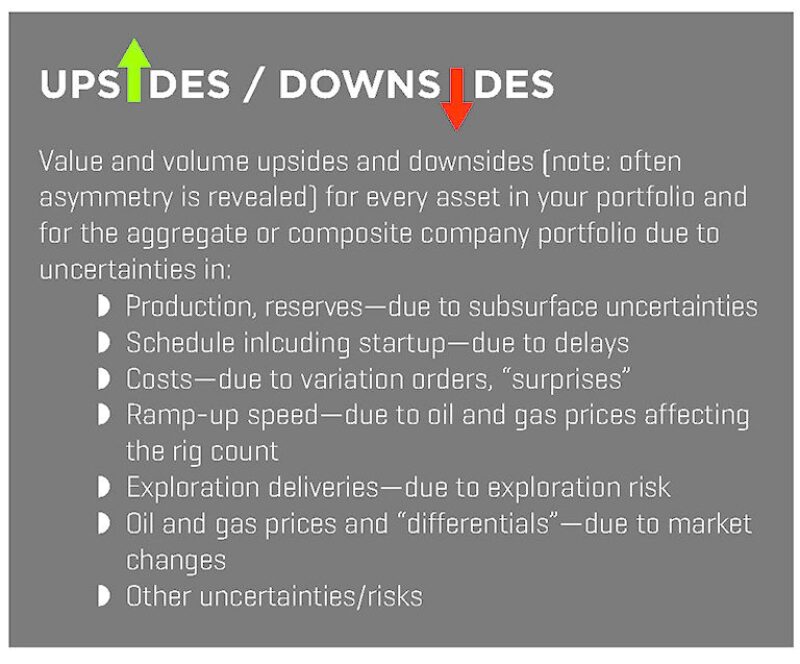
The three Ps that successful companies get right are: people, portfolio, and performance. And you cannot have one without the other. Great people select great portfolios and great portfolios deliver great performance. The exploration and production (E&P) industry is made up of thousands of companies exploring for and producing oil and gas worldwide. Common to all companies, whether listed on the stock exchange or not, is the need to have a vision, a mission, core values, a differentiating DNA or corporate culture and unique competitive advantages to avoid delivering below average performance results.
Also, every company develops an ambition and goals to achieve. They can be volume goals such as a certain production rate in 2020 or value goals such as growing net income by 30% in year X+1 over year X. The ambition, goals, and the strategy are communicated internally and externally and then it is time to roll up one’s sleeves and deliver. Most companies have a portfolio of assets, all along the E&P value chain from exploration to abandonment, some onshore, some offshore, all with their individual uncertainties, good risks (grisks) when you do better than the expected case and bad risks (brisks) when you deliver below the expected case. The forecasted production, reserves, schedule and costs are uncertain for each individual asset and for the aggregate, as is the forecasted oil and gas prices/price differentials.
In this column, I would like to discern how companies in 2015 arrive at ambitions, goals, strategies, downsides/upsides, and the aggregate or composite probability of goal delivery. This is a very important theme because not delivering on a company’s communicated goals has consequences in the marketplace. In a volatile, uncertain, complex, and ambiguous (VUCA) world, perhaps portfolio modeling is the key goal and strategy setting tool in 2015?

John I. Howell III, CEO and president of Portfolio Decisions, has been involved with E&P portfolio modeling for more than 25 years. He has advised hundreds of companies worldwide in the science and practice of portfolio modeling and has seen this forecasting tool and its use evolve. He answers my questions below.
The focus today is on generating value and a good return and profitable production growth to meet communicated ambitions. Is it possible to come up with a sensible ambition without running a portfolio model?
The key word here is “sensible.” It is possible to generate an ambition (or strategic goals) without a portfolio model. Companies do this all the time using a roll-up technique and man months of labor. The question is how confident are they that they can meet those goals? Using a goal-seeking portfolio analysis, we can generate multiple scenarios, all of which meet your goals in hours, not weeks. Using uncertainty analysis, we can also tell executives what the likelihood of meeting goals are for each scenario, and the extent of downside exposure. Strategic scenarios generated with a goal-seeking tool usually have 10% to 15% higher pro forma net present values than roll-up-based scenarios and they are usually 40% to 50% more likely to meet the goals. A powerful portfolio approach will generate better scenarios and do it faster than most conventional methodologies used today.
Is it still possible to get a premium valuation in the marketplace by just saying the right thing to investors in a five bullet point strategy summary and without running complex portfolio models?
The only companies who have ever been able to do this are those that have a history of hitting all their targets, year after year. Their historical performance gives the management team credibility. Unfortunately, in today’s complex and dynamic world, many companies miss their performance targets and then management loses credibility. In recent years, rising prices have protected many companies from mediocre plans. As commodity prices begin to drop, strategies that were dependent on high prices will be exposed and these companies will have a very hard time delivering on these strategic plans. Portfolio analysis is ideal for developing strategic plans that can help companies benefit from high prices, buffer the impact of price drops, and help companies track their progress throughout the year.
What is a portfolio model really useful for?
Portfolio models are most useful for framing strategic conversations at the executive and board levels. Whether the conversation is about capital allocation, mergers and acquisitions (M&A), or balancing value and growth, a portfolio analysis provides quantitative boundaries that guide and shape the executive conversations. Most know that a big deepwater success will add value and burden-free cash flow. But the question is how much? Will this success have unintended consequences of straining debt covenants? What if the success occurs when oil prices take a dip below USD 100/bbl? Do we have options? How should we respond? All too often, these questions are not answered quantitatively at the executive level or in the boardroom. Portfolio models will answer these questions quickly and in the context of the corporation’s strategic goals.
Do portfolio models help companies focus more on the long term in an otherwise quarter-to-quarter world? When is a portfolio analysis most useful?
Corporations need a strategy that yields competitive near term performance while also providing growth and sustainability in the midterm and long term. Goal-seeking portfolio models are ideal for exploring investment alternatives that balance these objectives. An uncertainty analysis is valuable in bringing to light portfolios that might look fine on an expected value basis, but that have unacceptable downside exposure, or a low probability of meeting goals.
Should every company have a portfolio model?
Most companies will benefit from a portfolio perspective on their business. As companies invest in diverse assets, the ability for them to survive on the intuition of their executives declines. Diversity can come in the form of different risks and uncertainties, different capital demand profiles, or different payout times to name just a few. Portfolio models should not be used to find the answer. Instead, they should be used to explore the potential sample space and inform or guide the decision makers.
Are sensitivities and scenarios even worth looking into?
Executives frequently find scenarios and sensitivities add little value, but this is because they usually look at them with deterministic views. Scenarios often look similar using deterministic displays, yet uncertainty analysis frequently shows substantial differences. For instance, using a deterministic forecast, two different scenarios might both show that a company can meet goals for production. But uncertainty analysis might show that one scenario only has a 40% chance of that, while the other has an 80% chance—quite a difference. Executives can focus on managing the probability of meeting goals and minimizing downside exposure when they integrate uncertainty views into their strategy discussions.

Must portfolio models be evergreen?
Yes. Portfolio models can aid executives with strategic decisions if they are kept evergreen. This is not as labor intensive as you might think. Portfolio models are less sensitive to daily and monthly variations in data than most people believe. Keeping a portfolio model evergreen is more about keeping probabilities current and project start dates current, and only reloading new data when large scale changes occur. Evaluating whether an exploration success requires that capital be reallocated, or whether an M&A opportunity should be pursued, does not require a total data refresh. These are simple analyses that can be performed in hours with a portfolio model.
What are the three most important portfolio modeling success factors in a company?
1. People. People are the biggest success factor for using a portfolio system. Executives have to be willing to explore alternate investment ideas. Sometimes this means seriously evaluating options that go counter to their intuition and experience. The portfolio manager who translates the portfolio results into a business discussion with the executives must understand the business and be trusted by the executives. Without this trust, the results will just be academic.
2. Address the most important business issues. The second most significant factor is that the portfolio system needs to be addressing the business issues that are most important to the executives. All too often, we see that strategy teams make the assumption that they know which issues are important. Our experience suggests that they are usually 75% to 80% correct, but that the real value often lies in the 20% that they are not addressing.
3. Data consistency. The final success factor is that the data must be directionally correct and consistent. Most companies spend way too much time trying to perfect their data. The vast majority of data revisions we see at the project level rarely (less than 5% of the time) change any decisions. Uncertainty should be characterized for the assets that have the most material potential impact on the aggregate performance of the company. For most companies, 10% to 20% of the assets control 80% to 90% of the uncertainty.
So, there you have it. Evergreen asset portfolio models, in the view of Howell, is a key tool in the 2015 E&P corporate toolbox for navigating success by setting composite achievable goals for a portfolio of assets, accounting for their inherent upsides and downsides, and for better managing expectations.
Industries are often analyzed by Harvard professor Michael E. Porter’s five competitive forces:
- Internal rivalry (in the E&P business)
- Threat of new entrants (to the E&P business)
- Threat of buyers (of oil and gas)
- Threat of suppliers (to the E&P industry)
- Threat of substitutes (e.g., renewable energy and electric cars)
I suggest adding two more forces in a holistic long-term risk analysis of E&P and a company’s portfolio. The first is a second “threat of buyers” force. This time, the buyers of your company stock or activist investors who could say: Do this or else! For example, cut
capital expenses, improve cash flow and deliver a better return on average capital employed. And the second, is a force to account for governments’ incentives, mandates, laws, and regulations. Rather than “the invisible hand of the market” (ref. Adam Smith) picking the winning energy resource or technology or business model, the not-so invisible hand of the authorities may increasingly pick the winners. In Norway for example, Tesla has been a best-selling car because of a number of advantages bestowed upon electric cars by governmental design. Building in these types of additional VUCA risks in a classical asset portfolio model is difficult. For example adding a carbon dioxide (CO2) emission tax to the long-term operating costs may be smart. It may also be smart to prepare your company asset portfolio for this day by seeking a low aggregate average number of pounds of CO2 emitted per barrel produced for your future portfolio by design.


